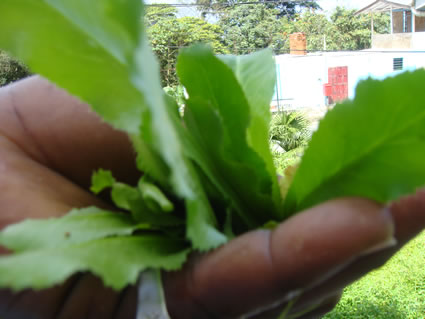Culinary Travel
in Tobago
A Fusion of Indian and Caribbean Flavors
Article and Photos by Meena Razvi

|
|
Fisherman's Bay in Tobago.
|
Spotting a Doubles vendor outside the airport terminal in Tobago is relatively easy on this small island, which is about 26 miles (42 kilometers) long and six miles (10 kilometers) wide. Locals and travelers racing in and out of the airport relish this fusion of Indian and Caribbean flavors, which symbolizes the mingling of races and cultures.
Along with other favorites like Buss Up Shut (local slang for “burst up shirt” because it tastes so good), Tobago is an ideal location to sample the foods of Trinidad and Tobago (T&T). Several undeveloped beaches make it a great place to visit and mingle with local people while sharing their cuisine. Not much bigger than the palm of my hand, a Double consists of two soft pieces of baked bread with a sandwich filling of mild curried potatoes and garbanzo beans and a mix of sauces that includes the option of a sprinkling of hot sauce.
Biting into Doubles releases the familiar tangy flavor of tamarind mingled with spices, followed by heat from a hot sauce that mimics the warmth of a tropical climate. Curious about the Doubles, I asked the young vendor, “How do you cook this?” All but one of the seasonings was familiar. Shadon Beni sounds more like the name of a person than an ingredient. “Is it a spice, a plant, or a dried spice?” I asked, eager to learn more. Third-generation Indians in T&T use it in their cooking, but it is not common in India. “Green,” said the vendor. “You chop it up and add it to curries, stews, and soups.”
Much of this trip would be spent tasting this elusive herb in various meals. Feeling like a detective searching for an elusive yet tantalizing foe that remained just out of sight, lingering in the shadows, Shadon Beni was not easy to track down. People would say, “Oh, it grows wild in my garden, but I don’t have it here,” or “It’s a plant with green leaves,” which pretty much sums up a multitude of possibilities since Tobago’s landscapes are so fertile that vibrant plants sprout everywhere almost out of control. The higher the elevation, the greener the scenery becomes due to the cool air, a plethora of rain, and abundant sunshine. No wonder everything thrives here — Tobago is a veritable gardener’s and cook’s paradise with multiple herbs, vegetables, spices, and fruits.
Mass tourism and large hotel complexes have yet to make it to Tobago, creating an atmosphere of natural, unspoiled beauty and local charm. Small roads winding along the coast meander off onto side streets leading to multiple beaches and bays. The main roads are in good condition and well-signed, so it is possible to drive around the island leisurely within two days with a map in hand. I do not give rides to strangers at home, but it is common practice to offer rides in Tobago, where public transport is almost non-existent. Mothers hitch rides early in the morning to take their children to school. Giving rides to local residents is a great way to connect with neighbors. Each one shares a small part of their life. Everyone knows one another in Tobago. Some offer advice about where to eat and what to see. You feel transported back to when people had time for each other, children played outside without fear, and neighbors helped each other in need. Two charming elderly ladies hop in for a ride to Scarborough market on the return trip, chatting amongst themselves about the decline of the younger generation. They insist on safely escorting me and my husband into the weekly market from the parking lot. Markets are a favorite pastime, offering local vegetables, fruits, homemade pickles and sauces, baked goods, spices, and an opportunity to sample local snacks.
There are few supermarkets or fast food chains in Tobago, and the island is too small and sparsely populated for retail giants to be interested. Most of the cafes and restaurants are locally owned, offering a variety of tasty meals made from fresh ingredients. Budget-conscious customers can also find cheap and flavorful specialties at roadside food stalls near busy areas. Some favorites like Roti (resembling a burrito with Indian ingredients) provides a portable and filling meal. In the village of Bloody Bay, one enterprising young woman sells slices of homemade cake. The lemon sponge cake was a personal favorite. Bakeries offer freshly baked snacks that are still hot when bagged, but most places do not open early enough for breakfast, so stocking up with snacks is a good idea.
Once you venture beyond crowded tourist zones like Scarborough and Pigeon Point, this may be the last unspoiled island in the Caribbean — with several undeveloped beaches. Castara, a local fishing village, offers a more tranquil pace of life. Tobago is more laid back than Trinidad, providing a perfect vacation for families with young children or those interested in quiet beaches, local cuisine, and freshly caught fish. Fishermen haul their daily catch upon strong shoulders right up to the fish seller on the beach. Walking along Castara beach, you can hear the noise of chopping at the fish seller’s counter while a group of local residents pass the time, waiting their turn to buy something for dinner. If you like fresh fish, there is nothing better than this.

|
|
Pigeon Point.
|
At a homely café on Englishman’s Bay, one of the staff, a third-generation Indian, cooks a traditional Buss Up Shut (flat bread torn into pieces, garbanzo and potato curry, greens, and mashed pumpkin) for lunch daily. (She added Shadon Beni to the dish but had no one around to show me.) I enjoyed eating lunch while sitting in the semi-open air café that offered a view of fishermen hauling in their nets, each man leaning back against the rope as he put his total weight into the effort. If I returned on Friday, the friendly cook offered to make some homemade hot sauce with Shadon Beni and local hot peppers. I did, and it was delicious. “My grandmother spoke Hindi with her friends when they chatted but I never learned it,” she said. “I use some words like Tawa (iron griddle) but I can’t speak it like she did.”
Persecuted for their foreign language, foods, and cultural ways, Indian migrants initially remained isolated and misunderstood by emancipated Africans and European plantation owners. Cooking in outdoor kitchens miles away from the nearest stores, indentured laborers made do with what they found locally. Indian recipes eventually fused with Carib ingredients until some dishes today resemble but do not fully duplicate traditional Indian cuisine.
Determined not to leave Tobago without finding Shadon Beni, I visited the village of Bloody Bay, where two local women offered to help me track it down. “Such a common thing,” said one woman, “it grows wild everywhere.” She called across the street to ask a neighbor if she had it growing in her yard, but no luck. Not willing to give up, she asked a couple of young men to check out a local hillside where a deep growth of foliage seemed to be a likely place where Shadon Beni might be lurking. Within a few minutes, one young man shouted down, “I got it!” I hurried up after him. He held a bright green plant in his hand with soft, pale green stems and long, jagged leaves.
Crushing the soft stems between my fingertips, I lowered my nose for a tentative sniff. This spicy aroma was very familiar. It smelled like Cilantro. Immigrants from India found Shadon Beni appealing — Cilantro is a common herb used in Indian cooking, and Shaddon Beni is a close relative of Cilantro. Known in other parts of the world as Culantro, Shadon Beni became a favorite additive for Indians laboring on hot plantations during the early migrations around 1857. After slavery was abolished in 1834 and no one was willing to work on farms, plantation owners initially tried to entice Chinese laborers (they came but left after finding the work too hard) and then searched elsewhere for likely recruits. Ravaged by famines in India, only the poorest laborers from India were willing to go to Tobago. They came searching for a better life but found harsh conditions on farms isolated miles from the nearest towns. Pioneers often make do with what they discover, so when Indian migrants discovered Shadon Beni, they used it as a welcome ingredient. Other ideas came out of similar necessities, like Buss Up Shut and Roti, which build a range of fusions utilizing a mix of Carib and Indian ingredients.

|
|
Shadon beni.
|
Food brings people together physically, culturally, and emotionally. Eating local foods provides intimate connections to the land, cultural norms, and values not easily understood from travel books. Third- and fourth-generation Indians have retained their food preferences, which still connect them back to their roots. Hunting for Shadon Beni brought us close contact with the cultures and people of Tobago.
Meena Razvi is a second-generation Indian cross-cultural consultant who currently resides in Elgin, Illinois. She is also a world traveler, freelance writer, adjunct professor of adult education, and lover of multicultural cuisine.
|
Related Topics
|
|
Culinary Travel
|
|
